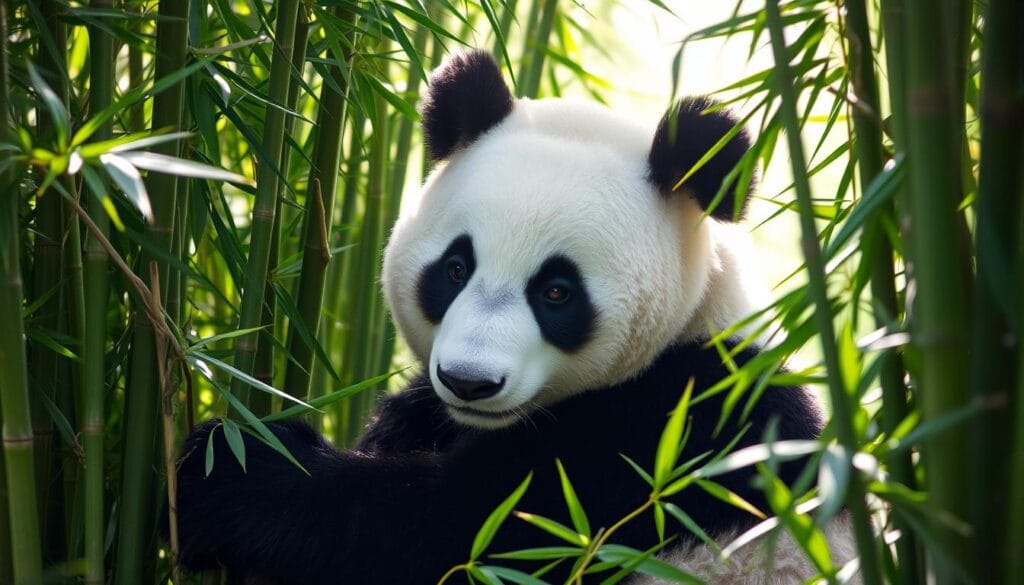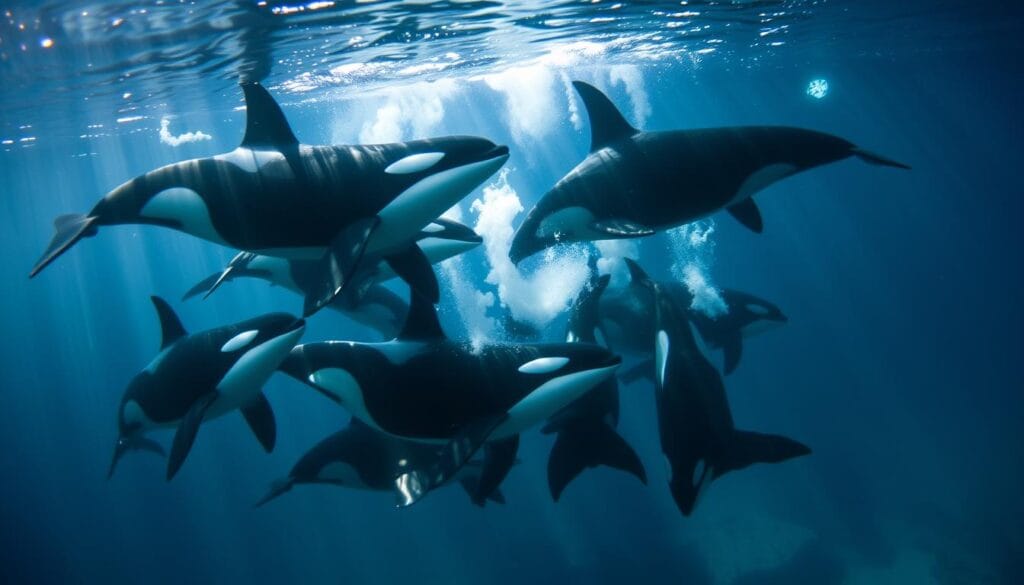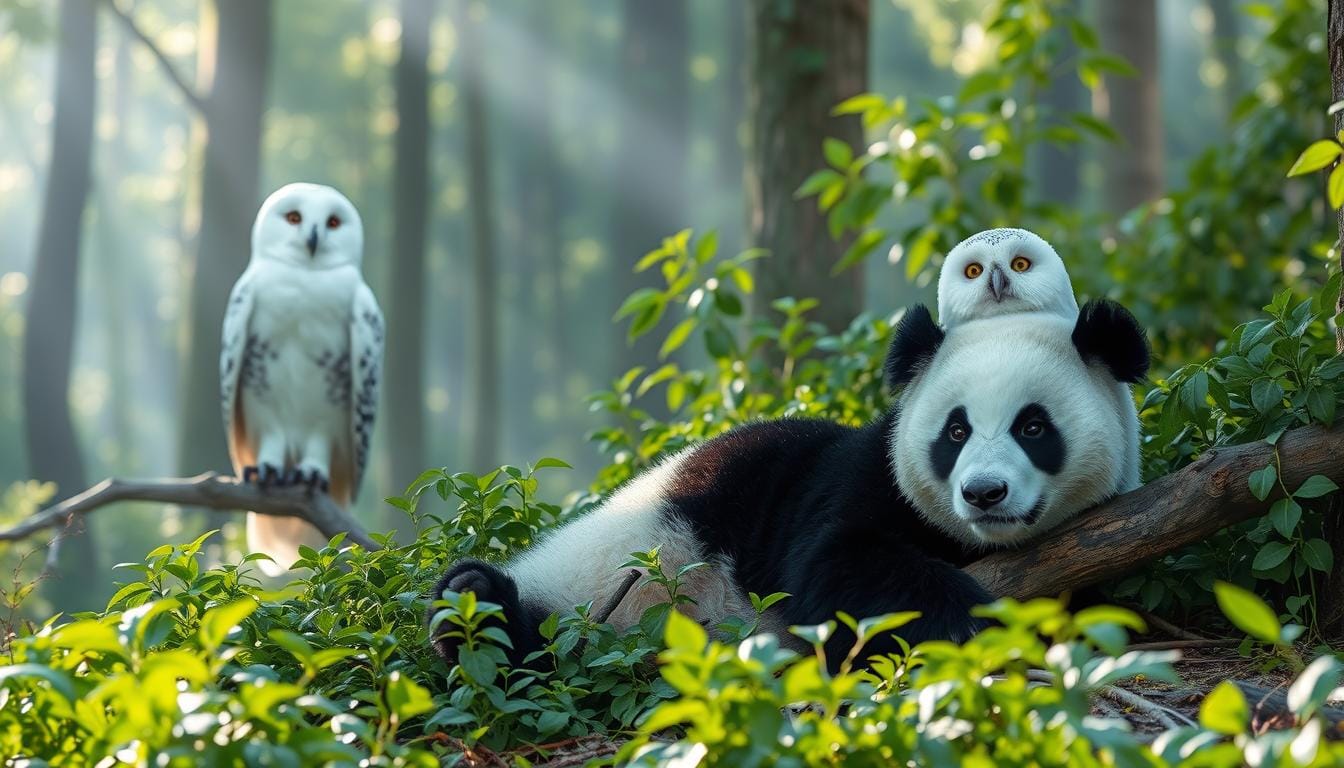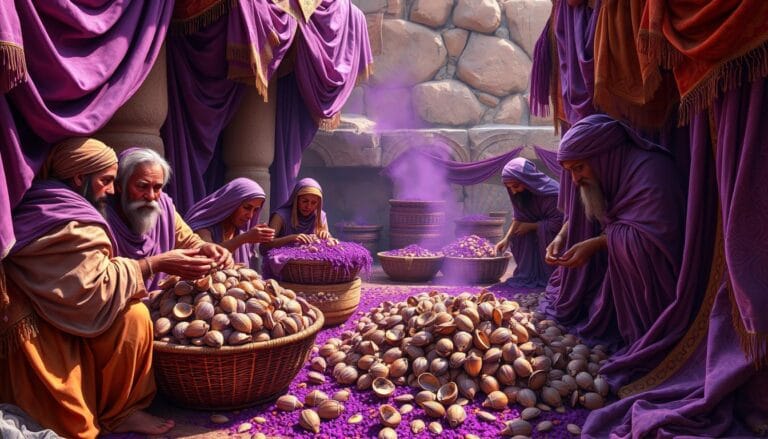Black-and-White Animals: Beauty, Symbolism, and Role in Nature
Nature paints its most fascinating creatures in bold monochromatic tones. Seeing a zebra’s striking stripes in a wildlife documentary captivated me. These creatures are not just visually stunning; they are living masterpieces of evolutionary design.
Black-and-white animals are a unique category in the animal kingdom. They show remarkable adaptations that go beyond their eye-catching appearance. Zebras, penguins, and pandas all use their color to survive.
Their two-tone coloration is not just for looks. It’s a survival strategy that helps them communicate and camouflage. Each black-and-white animal has a story of adaptation, resilience, and natural brilliance.
Understanding Black-and-White Animals in Nature
Nature has created amazing survival strategies with unique color patterns. Black-and-white animals show incredible adaptations for different environments. From pandas in bamboo forests to skunks on various terrains, these animals have evolved to thrive.
Evolutionary Advantages of Monochrome Coloration
Animal color patterns are not random. They are survival strategies. Black-and-white coloration offers many benefits:
- Camouflage in specific environments
- Temperature regulation
- Predator deterrence
- Social communication
Natural Selection and Color Patterns
Dalmatians show how selective breeding can highlight certain colors. In the wild, natural selection favors color patterns that help survive. Animals with good coloration are more likely to have offspring.
“Color is not just decoration in nature, but a powerful tool for survival” – Wildlife Biologist
Habitat Adaptation and Survival
Different black-and-white animals have unique survival strategies:
| Animal | Habitat | Adaptation Strategy |
|---|---|---|
| Pandas | Bamboo Forests | Camouflage among shadows |
| Skunks | Various Terrains | Warning coloration |
| Dalmatians | Domesticated | Distinctive breed recognition |
Understanding the link between color, environment, and survival shows nature’s incredible design.
The Science Behind Monochromatic Animal Patterns
Explore the amazing world of black and white animal coloration. Here, genetics and biology come together to create stunning patterns. Animals like black-and-white colobus monkeys and Malayan tapirs show off nature’s incredible design skills.
Animal color patterns come from complex genetics. Scientists found that certain genes control these patterns. These patterns serve many purposes in evolution.
- Melanin production determines black and white color intensity
- Genetic variations create unique pattern variations
- Color patterns provide critical survival advantages
Research gives us cool insights into how animals see colors. Different species see colors in different ways:
- Monochromatic vision: Animals like seals and dolphins see the world in shades of gray
- Dichromatic vision: Mammals like dogs can see some colors
- Trichromatic vision: Humans and some primates see many colors
“Color is not just aesthetic—it’s a survival strategy in the animal kingdom.”
Black-and-white colobus monkeys show how color helps in many ways. It can help with camouflage or social signals. The Malayan tapir’s unique two-tone body is another amazing example of nature’s color strategies.
Iconic Black-and-White Animals Around the World
Nature’s color palette shows us amazing black-and-white creatures. They capture our hearts and minds. From the wild to the coast, these animals have special ways to survive.
Land-Dwelling Black-and-White Species
Let’s dive into the world of monochromatic land animals. They have developed incredible ways to survive:
- Dalmatians with their unique spotted coats
- Skunks with bold black-and-white warning coloration
- Magpies known for their smart thinking
- Malayan tapirs with striking black and white patterns
Marine Black-and-White Marvels
The ocean is home to amazing black-and-white marine life. Killer whales, or orcas, are especially fascinating. They live in groups called pods, with 2 to 40 members.
Humboldt penguins are another incredible marine species. They are perfectly suited to coastal life with their black-and-white feathers.
| Marine Species | Unique Characteristics | Habitat |
|---|---|---|
| Killer Whales | Highly intelligent, social hunting behavior | Global ocean waters |
| Humboldt Penguins | Coastal dwelling, excellent swimmers | South American coastlines |
Aerial Black-and-White Species
The sky is home to its own black-and-white wonders. Magpies are a standout example. They are self-aware and can recognize themselves in mirrors, a rare ability in animals.
Black-and-white animals highlight nature’s remarkable diversity and unique survival strategies.
Pandas: Masters of Monochrome Survival

Explore the world of pandas, nature’s most famous black-and-white animals. These gentle giants have won hearts worldwide with their unique look and survival skills. Found in the mountain forests of central China, pandas show amazing adaptation in the animal world.
Pandas have a special black-and-white color that helps them hide in their home. Their white fur matches snowy landscapes, and their black patches blend in forest shadows.
“The panda represents conservation, emphasizing the delicate balance of nature and the importance of protecting endangered species.”
- Diet: Almost exclusively bamboo (99% of their diet)
- Daily eating time: Approximately 12-16 hours
- Habitat: Mountain forests of central China
- Conservation status: Vulnerable species
Understanding pandas is more than just their cute looks. They show incredible survival skills. They eat a lot of bamboo, which is not very nutritious. Their special digestive system and low-energy lifestyle help them live in tough places.
Protecting pandas is key to their survival. Thanks to conservation, their numbers have grown from near-extinction. They are now a symbol of global conservation, inspiring people to care for the environment.
Zebras and Their Unique Striped Patterns
Zebras are among the most interesting black-and-white animals in the world. They roam the African plains, showing off their unique stripe patterns. These patterns have fascinated humans for many years.
Function of Zebra Stripes
The black-and-white stripes of zebras are crucial for their survival. Scientists have come up with several theories about their stripes:
- Temperature regulation: Black and white stripes help manage body heat
- Insect protection: Stripes can deter biting flies
- Predator confusion: Creating visual illusions that challenge hunters
Social Behavior and Recognition
Zebras use their stripe patterns to recognize each other. Each zebra’s stripe pattern is as unique as a human fingerprint. This helps them quickly identify one another and maintain complex social structures.
Predator Confusion Theory
When zebras move together, their patterns create a “dazzle.” This optical illusion makes it hard for predators to pick out a single zebra. It’s a remarkable way for them to survive.
| Zebra Species | Weight | Conservation Status |
|---|---|---|
| Plains Zebra | Up to 400 kg | Near Threatened |
| Mountain Zebra | Up to 350 kg | Vulnerable |
| Grevy’s Zebra | Up to 450 kg | Endangered |
“The stripe pattern of a zebra is nature’s artwork, a masterpiece of survival and adaptation.” – Wildlife Researcher
International Zebra Day on January 31st celebrates these amazing animals. It raises awareness about their unique traits and the need to protect them.
Marine Monarchs: Orcas and Their Social Structure

Killer whales, or orcas, are amazing black-and-white animals in the sea. They are very smart and live in complex societies. Their social groups show how they communicate, work together, and survive.
Orca pods are like close families with special traits:
- Led by experienced matriarchs who guide survival strategies
- Possess complex communication systems involving distinct dialects
- Demonstrate advanced cooperative hunting techniques
The social lives of these black-and-white animals are truly amazing. Older females lead the group, sharing important knowledge. Their wisdom is crucial during tough times.
“Orcas represent the pinnacle of marine intelligence and social organization” – Marine Mammal Research Institute
They hunt in smart ways. For example, they use carousel feeding to catch fish. This shows their clever problem-solving and strong social bonds.
These incredible creatures are found in both cold and warm waters. They fascinate scientists and sea lovers everywhere. They show the amazing complexity of life in the ocean.
Penguins: Adaptation in Extreme Environments
Penguins are amazing survivors in the world’s toughest places. They have special ways to live in harsh conditions. This shows how nature can adapt in incredible ways.
Thermal Regulation Strategies
Penguins have unique ways to stay warm in freezing places. Their thick feathers and blubber keep them insulated. Emperor penguins can even survive temperatures below -50°C.
- Feather density provides critical warmth protection
- Blubber layer helps retain body heat
- Huddle techniques minimize heat loss
Social Behaviors and Community Life
Humboldt penguins and others live in complex societies. They work together to survive, like sharing egg incubation duties. This teamwork helps them hunt and stay safe.
| Penguin Species | Unique Social Behavior |
|---|---|
| Emperor Penguins | Male incubates egg for two months |
| Adélie Penguins | Mate for life, highly punctual |
| Humboldt Penguins | Nest in large coastal colonies |
Hunting and Survival Techniques
Penguins are skilled hunters in the sea. They dive deep to catch fish, squid, and krill. Gentoo penguins are the fastest swimmers, reaching speeds of up to 36 mph underwater.
“Penguins represent nature’s most extraordinary adaptation to extreme environments.” – Wildlife Research Institute
With 18 recognized species, penguins amaze scientists and nature lovers. They show incredible survival skills in the world’s harshest landscapes.
Symbolic Meaning of Black-and-White Animals in Different Cultures
Black-and-white animals have fascinated people all over the world. They tell stories of symbolism and spiritual importance. From the pandas of China to the zebras of Africa, these animals mean much more than their looks.
In China, pandas are seen as symbols of peace and harmony. Their black-and-white fur is linked to the yin-yang idea of balance. The panda’s role goes beyond beauty, showing the importance of diplomacy and understanding.
“Animals are not just creatures, but messengers of deeper cultural wisdom.” – Indigenous Cultural Wisdom
- Pandas symbolize tranquility and diplomatic relations
- Zebras represent individual freedom in African folklore
- Penguins embody community and perseverance
In North America, animals hold deep spiritual meanings. The Anishinaabe people have 7 animal totems with important spiritual lessons. These animals teach us through their unique traits and actions.
Black-and-white animals are important everywhere. They inspire us with their beauty and spiritual depth. From penguins to pandas, these animals capture our hearts and minds.
Conservation Status and Threats to Black-and-White Species
The world of black-and-white animals is facing big challenges. Species like pandas and penguins are under threat from human actions and environmental changes.
Human Impact on Habitats
Habitat destruction is a major threat to black-and-white animals. Deforestation, urban growth, and climate change are shrinking their homes.
- Fragmentation of natural landscapes
- Reduction in food sources
- Disruption of breeding patterns
Current Conservation Efforts
Global groups are working hard to save these amazing creatures. They use several strategies:
- Setting up protected wildlife reserves
- Starting breeding programs
- Creating international conservation agreements
“Protecting black-and-white animals is not just about saving a species, but preserving entire ecosystems.” – Wildlife Conservation Expert
Future Protection Strategies
New methods are being developed to protect black-and-white species. Technology and community involvement are key in these efforts.
| Species | Conservation Status | Population Trend |
|---|---|---|
| Giant Panda | Vulnerable | Increasing |
| African Penguin | Endangered | Declining |
| Black Rhino | Critically Endangered | Slowly Recovering |
Your support can make a big difference in protecting these fascinating black-and-white animals for future generations.
Black-and-White Animals in Human Society
Dalmatians have captured human imagination for centuries. They embody a unique role in our cultural landscape. These black-and-white animals are more than just pets – they are a blend of working animals and companions.
Historically, dalmatians played important roles in human society:
- Horse-drawn carriage guardians
- Firehouse mascots
- Protection and transportation companions
The bond between humans and black-and-white animals goes beyond dalmatians. These animals have a big impact on culture:
“Color is a power which directly influences the soul” – Wassily Kandinsky
| Animal | Cultural Significance |
|---|---|
| Dalmatians | Symbolic of protection and loyalty |
| Zebras | Representation of unique individuality |
| Pandas | Global conservation ambassadors |
Research shows that black-and-white animals have special effects on our perception. About 8% of men and 0.5% of women see colors differently. This might change how we see these animals.
Black-and-white animals continue to captivate us. From scientific studies to art, they are symbols of nature’s amazing design.
Conclusion
Exploring the world of black-and-white animals shows us how nature adapts and survives. Zebras in Africa and pandas in China are just a few examples. They show us the amazing designs and strength of nature.
These animals have clever ways to live. For example, pandas eat a lot of bamboo to survive. Zebras and penguins also find ways to thrive in tough places. This shows how diverse and amazing life on Earth is.
It’s important to protect these special animals. The good news is that pandas are no longer as endangered as they once were. Your help can keep their homes safe. This way, future generations can still see and learn from these amazing animals.
Thinking about black-and-white animals reminds us of their stories. They teach us about survival and the balance of nature. These animals are not just beautiful. They are also key to keeping our planet healthy.
FAQ
Why do some animals have black and white coloration?
Animals with black and white coloration have several reasons for it. It helps them blend in, stay cool, scare off predators, and talk to each other. Each species uses this color pattern in its own way to survive.
Are black and white animals more common in certain habitats?
You can find black and white animals everywhere, from snowy places to bamboo forests. They have special advantages in their homes, like hiding better or staying cool.
How do zebra stripes actually help them survive?
Zebra stripes do many things to help them. They keep flies away, help them stay cool, and confuse predators. This makes it hard for predators to pick out a zebra in a group.
Do all black and white animals have the same genetic mechanisms for their coloration?
No, each species has its own way of making black and white colors. It depends on how they make melanin, their genes, and how they color their fur or feathers.
Are black and white animals endangered?
Some, like pandas and penguins, are in big trouble. They face threats like losing their homes, climate change, and human actions. But, not all are in the same danger.
What is the most famous black and white animal?
The giant panda is very well-known. It’s famous for its looks and for needing our help to survive. Pandas are very important in China and for saving animals everywhere.
How do marine black and white animals like orcas use their coloration?
Orcas use their colors to hide in the sea. Their pattern helps them blend with the light and dark of the water. This is key for hunting and staying safe.
Can black and white coloration change in animals?
Animals can look a bit different as they age or if they’re sick. But, their main black and white colors usually stay the same.
How do black and white animals regulate their body temperature?
Animals with black and white colors have ways to stay warm or cool. For example, penguins keep warm with feathers and blubber. Others use their colors to reflect or absorb heat.
Are there any cultural significances to black and white animals?
Yes, black and white animals mean different things in different cultures. Pandas stand for peace in China, and zebras mean being unique in Africa. They carry deep meanings beyond just their looks.




